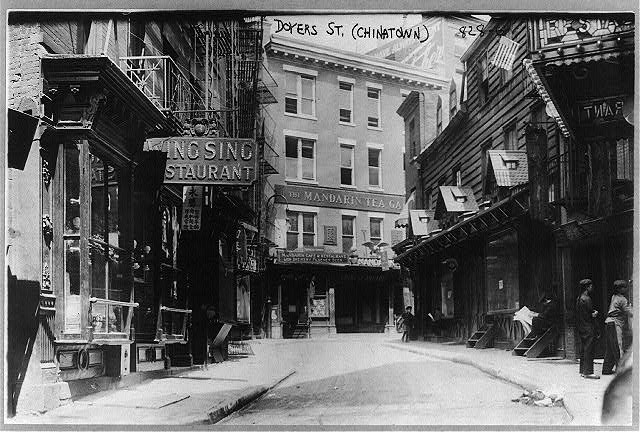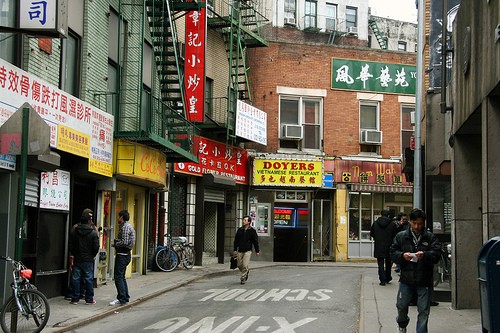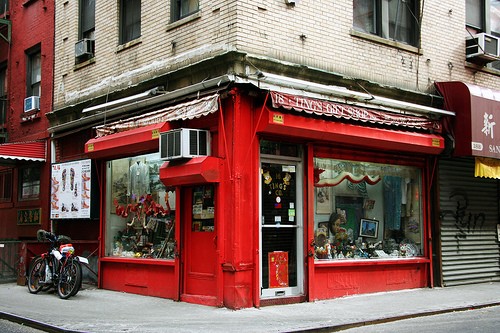Doyers Street
Introduction
Text-to-speech Audio
Located in Chinatown, Doyers Street is known as "The Bloody Angel" because of its bloody past. At the beginning of the 20th century, the street was the site of multiple gang shootings that resulted in a war between rival gangs over drugs, gambling, and prostitution in the area. Eventually, the fighting stopped because it was affecting business for everyone involved and cops began to crack down on illegal activity in the area. Doyers Street has since turned into a tourist attraction, but its bloody past is not far behind.
Images
Street in 1909

Street in 2010

Ting's Gift Shop

Backstory and Context
Text-to-speech Audio
Doyers Street was an old path through Manhattan before it received its name. The street was named after a distillery owner, Hendrick Doyer. From its earliest days, the Street was a prominent area for incoming immigrants who settled in New York City. Originally, Jewish, Irish, and Italian immigrants lived around Doyers Street. However, at the end of the 19th century, Chinese immigrants predominantly inhabited the streets surrounding Doyers such as Pell Street, Bayard Street, and Mott Street, and the area transformed into what would eventually become Chinatown. At the time, Doyers Street became a hub for drugs, gambling, and prostitution, but for a while, Doyers Street was absent of gang activity because of its cultural significance to the Chinese-American community, mainly due to the Chinese Theater located there.
At the start of the 20th century, years of growing gang activity finally erupted into a war between two prominent Chinese gangs, the Hip Sing Tong and the On Leong Tong. The first major shooting occurred in 1905 when several Hip Sing Tong members pulled pistols and shot four On Leong Tong members, killing two of them, at the Chinese Theater. This would be the start of a long and bloody war. In 1909, the war escalated further when a woman, Bow Kum, was murdered by a Hip Sing assassin because she was believed to be the property of another man. After the murder of Bow Kum, violence ramped up to an unprecedented level in Chinatown, and Doyers Street became the center of that violence because of its unique curve and underground tunnels which made fleeing after an attack much easier.
Peace came to Doyers Street in 1913 after four years of intense war. Though violence did not end completely, the two gangs could no longer justify losing money because patrons were too afraid to enter the businesses on Doyers Street for fear of death. However, violence erupted again in the late 1980s when the Flying Dragons, who were associated with the Hip Sing Tong, went to war against the BTK, a Vietnamese gang that arose after the Vietnam War. Violence from these two gangs flooded Doyers Street until 1994 when cops started cracking down on illegal activity in Chinatown. Today, Doyers Street is more of a tourist attraction than a war zone, but the Street's bloody past is still remembered.
At the start of the 20th century, years of growing gang activity finally erupted into a war between two prominent Chinese gangs, the Hip Sing Tong and the On Leong Tong. The first major shooting occurred in 1905 when several Hip Sing Tong members pulled pistols and shot four On Leong Tong members, killing two of them, at the Chinese Theater. This would be the start of a long and bloody war. In 1909, the war escalated further when a woman, Bow Kum, was murdered by a Hip Sing assassin because she was believed to be the property of another man. After the murder of Bow Kum, violence ramped up to an unprecedented level in Chinatown, and Doyers Street became the center of that violence because of its unique curve and underground tunnels which made fleeing after an attack much easier.
Peace came to Doyers Street in 1913 after four years of intense war. Though violence did not end completely, the two gangs could no longer justify losing money because patrons were too afraid to enter the businesses on Doyers Street for fear of death. However, violence erupted again in the late 1980s when the Flying Dragons, who were associated with the Hip Sing Tong, went to war against the BTK, a Vietnamese gang that arose after the Vietnam War. Violence from these two gangs flooded Doyers Street until 1994 when cops started cracking down on illegal activity in Chinatown. Today, Doyers Street is more of a tourist attraction than a war zone, but the Street's bloody past is still remembered.
Sources
Carr, Nick. Chinatown’s “Bloody Angle” — A Trip Down Doyers Street. Huffington Post. 5/25/11. Accessed Web, 8/27/17. http://www.huffingtonpost.com/nick-carr/chinatowns-bloody-angle_b_508118.html.
Hines, Nickolaus. Hatchets and Blood: Scenes and Stories From the Deadliest Street in the United States. ATI. 7/20/17. Accessed Web, 8/27/17. http://all-that-is-interesting.com/bloody-angle.
Hines, Nickolaus. Hatchets and Blood: Scenes and Stories From the Deadliest Street in the United States. ATI. 7/20/17. Accessed Web, 8/27/17. http://all-that-is-interesting.com/bloody-angle.
